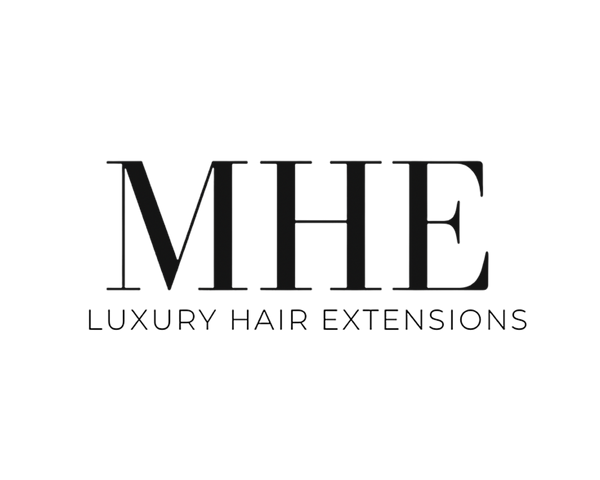Clip-in hair extensions are the easiest way to add instant length and volume to your head, but are they damaging to your natural hair?
This short answer: No.
Clip-in extensions are not inherently bad for your hair, however, improper use can lead to thinning, scalp tension or breakage.
Issues can often arise when extensions are worn too frequently, not applied correctly and not maintained/cared for properly.
In this blog, we’ll cover
- Whether clips-ins can cause hair damage.
- Tips for preventing damage and safe application.
- The link between clip-ins and traction alopecia.
Do Clip-In Hair Extensions Cause Hair Damage?
A common misconception is that clip-in extensions cause hair damage. This is a myth. The reality is that clip-ins are actually the least damaging type of hair extension when applied and looked after correctly.
Potential Risks of Clip-in Extensions
That being said, there are still some potential risks with clip-ins if not applied correctly.
Excessive pulling
Improperly placed clips can cause excessive pulling on your natural hair. This can be especially harmful for thinner/finer hair.
Wearing extensions too often
Daily wear can cause strain to your hair. If you are using clip-ins daily, we recommend taking them off once you’re home to prevent the excessive pulling and strain that can occur.
Not removing before sleeping
MHE recommends removing your clip-ins prior to sleeping and storing them correctly. Sleeping in your clip-in extensions can cause tangling, scalp irritation and damage to the clips.
Clip-Ins vs Other Extensions
So how do clip-ins compare to other extensions regarding hair damage?
Tape-ins, microbeads and keratin bonds all require some sort of adhesive or heat which can cause more damage than clip-ins.
When applied by a professional, there is little damage with these types of extensions, but if your hair is more fragile, there can be some issues.
Clip-ins on the other hand, allows for a temporary styling option without the long-term commitment or strain on your hair.
MHE Tip: If you feel tension or discomfort while wearing clip-ins, they may be applied too tight or incorrectly. Try readjusting the clips until you find a comfortable fit.
How to Prevent Hair Damage from Clip-in Extensions
The key to avoiding hair damage with clip-ins is proper use and care. Here are some MHE tips that we recommend to our customers.
Tip #1. Apply clip-ins correctly
- Place the clips securely onto sturdy sections of your hair, avoiding weak or fragile areas.
- Distribute the wefts evenly to avoid concentrated stress in one spot on your head.
- Avoid placing clips too close to the scalp. This causes unnecessary strain and pulling, and also makes them more obvious, giving a slightly unnatural look.
Tip #2. Limit how often you wear clip-ins
- Wear clip-ins only when needed and avoid excessive, everyday use if possible.
- If you do wear them everyday, make sure to take off in the evening when you get home to give your hair some time to recover.
- Always remove clips before sleeping to prevent tension and tangling overnight.
Tip #3. Detangle gently
- Use a soft-bristle brush to remove knots.
- Brush from the ends of the extensions up to avoid pulling on the roots.
Tip #4. Maintain your hair’s health
- Keep your natural hair moisturised to prevent dryness and breakage.
- Use a lightweight hair serum to nourish your scalp.
Clip-In Extensions and Traction Alopecia
Traction alopecia refers to hair loss that occurs as a result of constant pulling on your hair (Healthline). The constant pulling from your clip-in extensions can lead to damage on your hair follicles, leading to hair thinning or loss.
While a concern for some, clip-ins won’t cause traction alopecia unless worn too frequently or improperly.
To avoid any risk of traction alopecia with clip-ins
- Avoid wearing clip-ins everyday (if possible).
- Never attach to fragile or thinning hair.
- Avoid heavy extension and apply minimal pressure.
- Rotate the application areas to reduce tension on the same sections of your hair.
MHE Tip: If you notice thinning or discomfort, take a break from extensions and focus on strengthening your natural hair.
FAQs
Can clip-in extensions permanently damage my hair?
No, but improper use and maintenance can lead to breakage. Avoid wearing them too often or placing them too tightly if possible.
Are clip-ins safer than other extensions?
Yes! Clip-ins don’t require glue or heat to be applied, making them the least damaging option for hair extensions.
How often can I wear clip-in extensions?
While clip-in extensions can be worn daily, we recommend giving yourself a break where possible to avoid constant strain on your hair.
Can I sleep in clip-in extensions?
No, always remove your clip-ins before sleeping to avoid tension and damage to your hair or the extensions.
Are Clip-In Extensions Bad for Your Hair?
Clip-ins are not bad for your hair, especially if applied and used correctly. In fact, they are probably the least damaging extension option out there!
The key is to apply them properly, maintain your hair health, avoid excessive pulling, limit your usage and remove before sleeping.
If you’re looking for high-quality clip-in extensions that aren’t damaging on your hair, check out our collection below.





